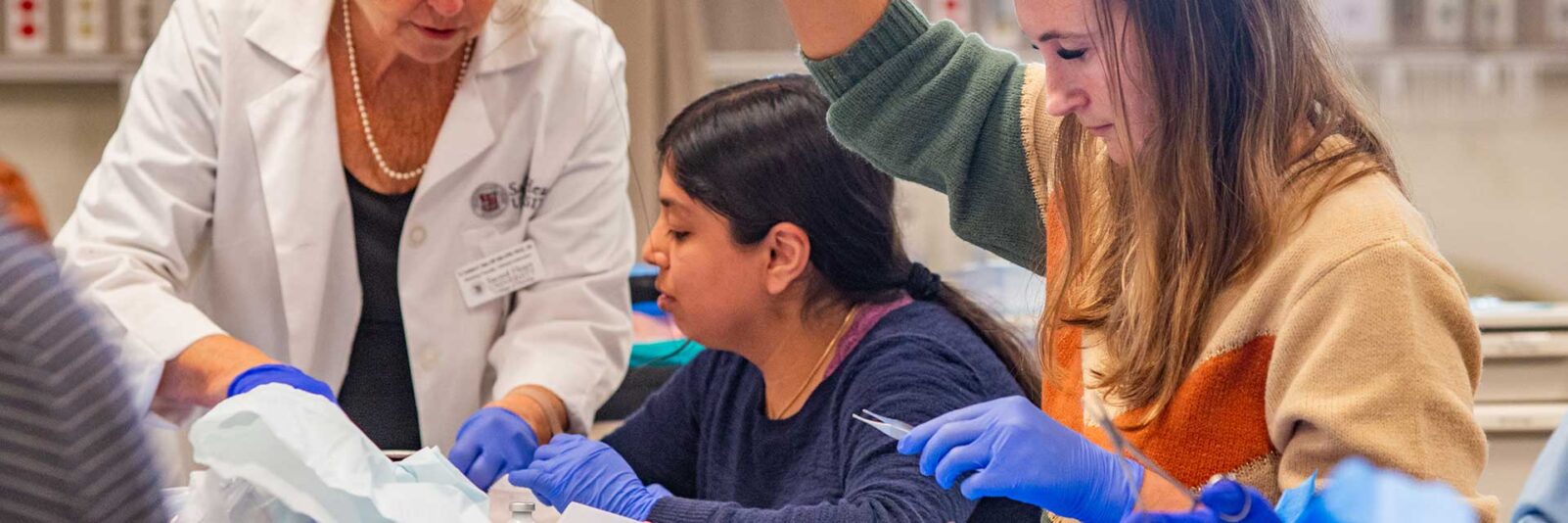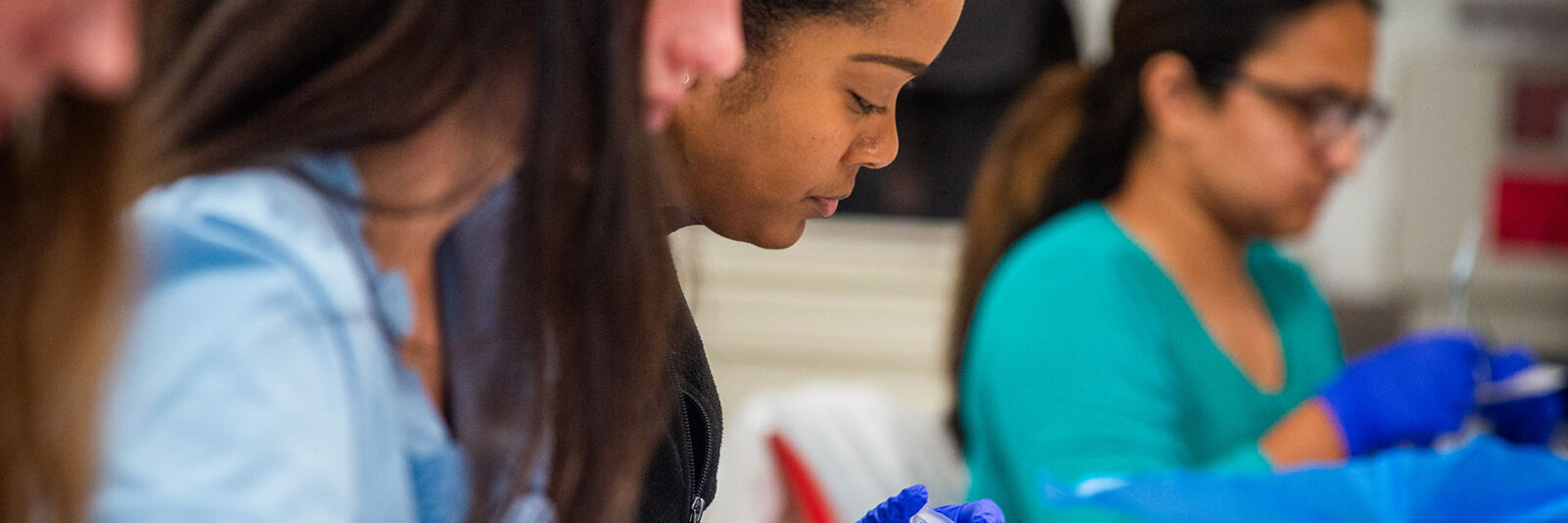RN to MSN Online
Registered Nurses Can Earn Their MSN in 3.5 Years
With our CCNE-accredited RN to MSN online program, you’ll graduate with the experience and credentials needed to meet the increased demand for advanced practice registered nurses. Employers are projected to post about 32,000 jobs per year through 2033.1 With the program’s faster pathway to advancement, you’ll be better positioned to meet that demand.
Rankings and Accolades
Best Online Master’s in Nursing Programs (U.S. News & World Report)2
Best Value Online MSN Programs (Value Colleges)3
Nursing Colleges of Distinction4
Program Benefits
- An academic team led by full-time expert nurses
- Clinical or practicum opportunities close to home
- No GMAT/GRE scores required
- Your prior education counts—transfer up to 90 credits
- You can choose from five specializations at the MSN level
- It’s faster and more cost-effective—save time and money by earning your BSN and MSN in a single program
Sacred Heart University’s MSN Specialty Tracks
Seize the opportunity to grow your career by entering as an RN and advancing in your nursing knowledge, role and salary while improving the patient care you deliver. After completing the major requirements and signature core curriculum elements, you can expand your nursing expertise in one of our master-level specializations.
Our Curriculum Prepares You for Two In-Demand Degrees
51–153 credit hours
Experienced faculty
Our online RN to MSN pathway allows you to complete the coursework for two degrees in a single program. You’ll begin with Sacred Heart University’s signature core curriculum, The Human Journey, which explores what it means to be a human being through literature, philosophy, religion, sociology and more.
You’ll then move on to complete BSN and MSN coursework that builds expertise in health care policy, evidence-based practice and more. You can choose from five MSN specializations to tailor your education to your career goals. If you choose the family nurse practitioner and psychiatric mental health nurse practitioner specialization, you’ll also complete an on-campus residency.
Course Highlights
- NU 315 The Human Journey in Nursing
- NU 501 Health Care Policy & Ethics for Contemporary Nursing Practice
- NU 601 Principles of Health Care Research for Contemporary Nursing Practice
- NU 602 Evidence-based Practice for Quality Care
Learn How to Begin the RN to MSN Online Program
No GRE/GMAT Requirement
Transfer up to 90 credits
Apply for Sacred Heart University’s online RN to MSN accelerated program by meeting the following requirements. You also do not need to provide GRE or GMAT scores, making it easier to get started. Visit the admissions page for full details.
| Online Application Form | Apply Now |
| Application Fee | $75 |
| Degree and Minimum GPA | Associate’s Degree in Nursing (ADN) or a Diploma in Nursing, with a minimum 3.0 GPA on a scale of 4.0 Family Nurse Practitioner and Psychiatric Mental Health Nurse Practitioner specialization GPA Requirements: 3.2 GPA on a scale of 4.0 |
| Transcripts | Official transcripts of all prior nursing and academic work |
| Official GMAT/GRE | No GMAT/GRE scores required |
| Additional Requirements |
|
Cost-Effective Tuition for RN to MSN Students
$390-$955 per Credit
$28,380 – $65,565 Total Tuition
Competitive tuition and transparency are priorities at SHU. In response to the critical need for BSN-trained nurses, we’ve deepened our commitment to providing greater access to quality nursing education — the online RN-BSN now costs just $390 per credit hour. Compared to our tuition rates in 2020, this is a $200 per-credit-hour savings. Visit our tuition & fees page for more details.
Tuition & FeesGraduate Fully Prepared for Magnet Positions
Many hospitals are pursuing the American Association of Colleges of Nursing’s Magnet Recognition, the gold standard for health care that emphasizes the importance of BSN-educated nurses. Stand out for roles with those facilities by completing Sacred Heart’s RN to MSN online program. Depending on your specialization, you can get on track for these and other positions:
- Chief Nursing Officer
- Clinical Educator
- Clinical Nurse Leader
- Family Nurse Practitioner
- Psychiatric Nurse Practitioner
Where You’ll Find Our RN to MSN Graduates
- Hospitals
- Physicians’ offices
- Community health agencies
- Clinics
- Universities
In-Demand Roles with Solid Earning Potential
Advanced Practice Registered Nurse 40% Job Growth (2023 to 2033)1
MSN-Educated Nurse $104,000 Average Annual Salary5
What You’ll Learn
Sacred Heart University’s online RN to MSN program derives its student learning outcomes from the American Association of Colleges of Nursing Essentials: Core Competencies for Professional Nursing Education (2021), Advanced Level Competencies and Sub-Competencies. Upon completion of this program, graduates will demonstrate the following outcomes.
Program Outcomes
- Translate into action the knowledge from philosophical and theoretical traditions of nursing science and other disciplinary perspectives to facilitate the ethical integration of evidence-based practice to advance nursing scholarship.
- Lead collaboratively within the interprofessional team to develop and evaluate plans of care with evidence-based, person-centered care principles promoting quality and safety outcomes.
- Collaborate with strategic partners to implement health policy while advocating for equitable and sustainable population health care.
- Integrate complex systems-based practice to develop innovative and evidence-supported equitable solutions to improve health outcomes across the lifespan of diverse populations.
- Apply best practices of informatics and communication technologies in diverse care settings to collect, analyze and synthesize data to promote quality and safe health care outcomes.
- Demonstrate professional behaviors reflecting current regulations, policies and practice integrating professional concepts, including ethics, compassion, diversity, equity and inclusion.
- Model leadership within the nursing profession that embraces self-care, a spirit of inquiry, advocacy, change, mentorship and service to others.
“The online RN-MSN program is very flexible. It allows you to work your schedule around your job and family and study at your own pace.”
– Monika Costa, RN to BSN to MSN, Nursing Education Specialization
Faculty: Accomplished and Accessible
In your online RN to MSN, you’ll learn from faculty members who have years of experience in their nursing specialties, extensive scholarly credentials and cutting-edge knowledge from the field. In addition to being well-versed in online teaching, our award-winning professors are available to answer your questions and offer support as you take the next step in your nursing journey.

Heather Ferrillo, chair of undergraduate nursing programs & assistant professor
Faculty Spotlight: Heather Ferrillo, PhD, MSN, APRN, FNP-BC, CNE
Heather Ferrillo is Chair of Undergraduate Nursing Programs and assistant professor in the Davis & Henley College of Nursing at Sacred Heart University. Her research interests include professional value development in International Service Learning and the evaluation of innovative teaching methods in undergraduate nursing education.
Dr. Ferrillo joined Sacred Heart in 2001 and has taught in the undergraduate and family nurse practitioner programs. She holds a BSN from Western Connecticut State University, an MSN/FNP from Sacred Heart University and a Ph.D. in nursing education from Nova Southeastern University. She is a board-certified family nurse practitioner and certified nurse educator.
Dr. Ferrillo has maintained clinical practice as a nurse practitioner in cardiology for the past 23 years. She is a member of the board of directors for Sage HealthCare Community Health Center in Bridgeport and subcommittee chair on the American Association of Colleges of Nursing Faculty Leadership Network Steering Committee. She has published and presented nationally and internationally in nursing education, leadership, global nursing and vaping education.

Linda L. Cook, Clinical Associate Professor & Director, MSN Clinical Nurse Leader Program
Faculty Spotlight: Linda L. Cook, DNP, APRN, NNP-BC, CNL
Linda L. Cook is the clinical associate professor and Chair of the graduate programs in the Davis & Henley College of Nursing at Sacred Heart University. She earned her BSN at Ohio State University, MPH at New York Medical College, Neonatal Nurse Practitioner Certificate at Georgetown University and DNP at the University of Connecticut.
Dr. Cook’s professional and research interests include neonatal care, obstetrics, pediatrics, compassion and caring in online teaching and clinical nurse leadership. She is a certified CNL and certified neonatal nurse with additional related certifications. She has been in practice as a neonatal nurse practitioner since 1990.
Dr. Cook joined the nursing faculty of Sacred Heart University in 2011. She was awarded the National AACN/CNC CNL Educator Award in February 2025. She was nominated in the Final 4 for the Dr. Marian Calabrese Outstanding Faculty Award in 2017 and awarded the Outstanding Doctoral Student DNP Award from the Mu Chapter of Sigma Theta Tau in 2010, the Nightingale Award for Excellence in Nursing in 2009 and the Nurse Exemplar Award in 2003.
Why Learn Online?
Flexible Learning: Study at your own pace and on your schedule, fitting education into your busy life.
Expert Faculty Support: Learn from the same accomplished faculty as on-campus students, with personalized, one-on-one guidance.
Equal Opportunities: Access the same resources and opportunities as on-campus students, ensuring a comprehensive and enriching experience.
ONLINE AT SHUFinancial Aid
At Sacred Heart University, we strive to offer competitive tuition and encourage you to explore all financial aid options, including federal aid, U.S. military benefits and available scholarships.
FINANCIAL AIDFrequently Asked Questions
If you have a question we don’t cover here, request more information or call 877-791-7181.
You can take as long as six years to complete the program.
You may transfer up to 90 credits, meaning you would need 54–57 credits from Sacred Heart University (depending on the specialization you choose) to complete the BSN and MSN.
For the BSN portion of the program, you’ll complete 72 clinical hours. The number of clinical hours you need to complete for the MSN depends on the specialization you select. They are as follows:
- Clinical Nurse Leader: 420 hours
- Family Nurse Practitioner: 540 hours
- Nursing Education: 180 hours
- Nursing Management and Executive Leadership: 120 hours
- Psychiatric Mental Health Nurse Practitioner: 540 hours
The BSN program does not offer a specialization. Within the MSN, you’ll choose from 5 specializations:
The BSN does not have licensure. Graduate work in the online MSN Clinical Nurse Leader specialization prepares you for the AACN’s CNL Certification Exam. The online MSN in Clinical Nurse Education specialization will prepare you for Nurse Educator certification from the National League for Nursing.
Sources
- Bureau of Labor Statistics, U.S. Department of Labor. Occupational Outlook Handbook. “Nurse Anesthetists, Nurse Midwives, and Nurse Practitioners.” Retrieved February 6, 2025, from https://www.bls.gov/ooh/healthcare/nurse-anesthetists-nurse-midwives-and-nurse-practitioners.htm.
- U.S. News & World Report. “Sacred Heart University.” Retrieved February 6, 2025, from https://www.usnews.com/education/online-education/sacred-heart-university-130253.
- Value Colleges. “Top 25 Best Value Online MSN Programs in the US.” Retrieved February 6, 2025, from https://www.valuecolleges.com/rankings/best-value-online-msn-programs/.
- Colleges of Distinction. “Sacred Heart University.” Retrieved February 6, 2025, from https://collegesofdistinction.com/school/sacred-heart-university/.
- Payscale. “Master of Science in Nursing (MSN) Degree.” Retrieved February 6, 2025, from https://www.payscale.com/research/US/Degree=Master_of_Science_in_Nursing_(MSN)/Salary.






